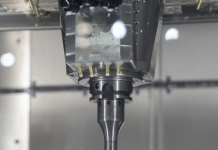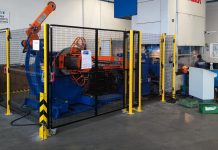 The additive manufacturing is based on an innovative concept: the component, of whatever shape, is designed on 3D Cad systems and, then, without turning to conventional technologies, such as stock removal and/or assemblies. How is it then implemented? Building it by superimposition, layer by layer.
The additive manufacturing is based on an innovative concept: the component, of whatever shape, is designed on 3D Cad systems and, then, without turning to conventional technologies, such as stock removal and/or assemblies. How is it then implemented? Building it by superimposition, layer by layer.
Among the Additive Manufacturing methods, the selective laser melting of metal materials (Selective Laser Melting – SLM), known also as Direct Metal Laser Sintering – DMLS is often deemed a variant of the standard Selective Laser Sintering (SLS) technology because you achieve the complete melting of the metal powder.
An interesting customization of the Selective Laser Melting is represented by the LaserCUSING® technology, proposed by Concept Laser, which might lead to a revolution both in high quality components and in the mould and die making sector.
Lasercusing
The development of the LaserCusing process started in 1998, followed, a couple of years later, by the establishment of Concept Laser GmbH, part of Hofmann Innovation Group. Since then, various patents have been registered, including the Stochastic Exposure, which grants a significant reduction of the component stresses. The patented laser melting process generates components layer by layer, even with very complex geometries, using 3D CAD data.
The LaserCUSING technology works with fine metal powders, locally melt by a fibre laser; the piece profile is obtained by orienting the laser beam, through a mirror unit. The components are manufactured by successive layers, having 20÷50 µm. depth.
The used materials depend on the application and can be Aluminium alloys, Titanium alloys, but also pure Titanium, Chrome-Cobalt alloys, Nickel-based Superalloys, as well as precious alloys and various other metals that are gradually developed. The material density is close to 100%, then with mechanical characteristics that are comparable to those of parts machined from the solid.
This technology finds several application fields, in particular wherever are requested complex geometrical shapes and/or materials of difficult workability, in short where traditional techniques show strong criticalities. Various are the applications in the aeronautical sector, where the manufactured good is expected to feature both performances and lightness: the possibility of coupling optimized shapes with highly performing materials with low specific weight prove to be winning. Moreover: producing a manufactured item with selective laser melting, that is to say by successive layers, allows reducing, or completely zeroing, the number of assemblies, thus creating a single component.
The aeronautical field is not the only one benefitting from this technology: besides the mould and die industry, stand out the medical and dental applications and the gold sector.
For the dental sector, it is possible to manufacture single elements, bridges, dentures and implants, in fast and precise manner, starting from the digital scanning of the model, then converted into 3D CAD file that, once processed, will be then sent to the machine for the additive manufacturing. The machining is very fast because the volume to be created is small and with excellent aesthetic qualities. It is worth pointing out the medical field, where the use of the LaserCUSING technology is opening new perspectives. As a matter of fact, it is possible to realize both prostheses and Titanium bone structures, absolutely customizable, target unconceivable and unfeasible by working according to traditional technologies.
Machines and solutions
Concept Laser proposes machines based on LaserCUSING® technology in 3 different sizes, differing by the “cube” size, that’s to say the machining area within which occurs the Selective Laser Melting process, which creates the manufactured good layer upon layer.
Small machines have a 90 mm-cube, medium ones, the most used, a 250 mm one, while the big ones, called XLine, have a 630x400x500 mm machining field. The latter are the biggest machines in the world for the Selective Laser Melting and essentially find application in the aerospace sector.
The fibre laser has powers ranging from 100 W to 1 KW.
All Concept Laser machines rely on implemented process quality control systems, called QM Systems, which are increasingly targeted, in order to grant the validity of the outgoing piece. The control occurs through QM modules, which allow the monitoring and the control of the various machine parameters, like the laser efficiency, the documentation of the chamber atmosphere, temperature, control of the melting basin, the powder laying off and the relative quality and temperature. Naturally, once collected the signals, the analysis must be accomplished in real time, in order to intervene immediately, if necessary. In the case of conventional machining, the analysis in real time is currently still very difficult. The process monitoring is performed by a photodiode camera, able to supply 13,000 images, processed in real time by dedicated software that indicates where and if we are exceeding the target.
The Selective Laser Melting Process is strongly influenced by the characteristics of the melting basin, which are determined by the intensity of the laser beam in the powder bed, by the process gas and by the powder bed: important is the scanning strategy, determined by the laser beam passage modality. This means to pay attention to the powder and to the scanning speed, to the composition and the behaviour of the gas flow, to the material properties and to the layer thickness.
The isle machining principle
The scanning strategy is determined by the modality of the laser beam passage. The peculiarity of LaserCUSING® machines is that they work according to the stochastic exposure strategy (already patented at the end of the Nineties) of laser segments, with the “isle principle”. The segments of each single layer, the so-called “isles”, are machined in sequence, according to a stochastic selection. Actually, the laser melts the metal powder in a certain segment, then it moves towards a distant segment, in order to grant the thermal surface balance. This process, protected by patent, assures a relevant reduction of piece stresses, minimizes deformations, allowing the generation of massive components and of big volumes.
Concept laser
Concept Laser is an independent Company of the German Group Hofmann Innovation Group Gmbh, specialized in the Additive Manufacturing of metal materials, both in the rapid prototyping and production. In Italy, Concept Laser is imported and represented by the Piedmontese Ridix SpA that, for almost half century, has been proposing forefront technology and products to the Italian engineering market.
Concept Laser is present on the market with plants for the manufacturing, layer by layer, of pieces with whatever geometry, made of different metal types. The reference technology concerns the selective powder melting, through the innovative LaserCUSING® process. By means of this process, it is possible to make manufactured goods with whatever geometric shape of steel, aluminium alloys, titanium alloys, Inconel and precious alloys, reaching a density close to 100% and hardness up to 54 HRC.
http://youtu.be/bwH66LSsGTk
The ‘eurofighter typhoon case
An interesting example of additive design and production with LaserCUSING technology is represented by the elbow of the emergency oxygen supply system for Eurofighter Typhoon, made of AiSi 316L stainless steel. The component is requested to feature:
Operating resistance at 200 bars without leakages
Burst pressure resistance of 400 bars
The demanded quantity of components is, indicatively, of 100 units/year The design and the implementation, proceeding according to traditional schemes, of the concerned elbow part, provided for:
Stock removal machining of the housing
Welding of part of the duct
Stock removal machining of the elbow
Welding of part of the duct with threaded engagement
With the conventional production, problems of leakages in the component anyway aroused, essentially due to junctions.
Exploiting the possibilities offered by the Additive Manufacturing, redesigning the system, leakages were eliminated thanks to the functional production integrated in a single process, with a relevant impact also on the cost and time reduction.



